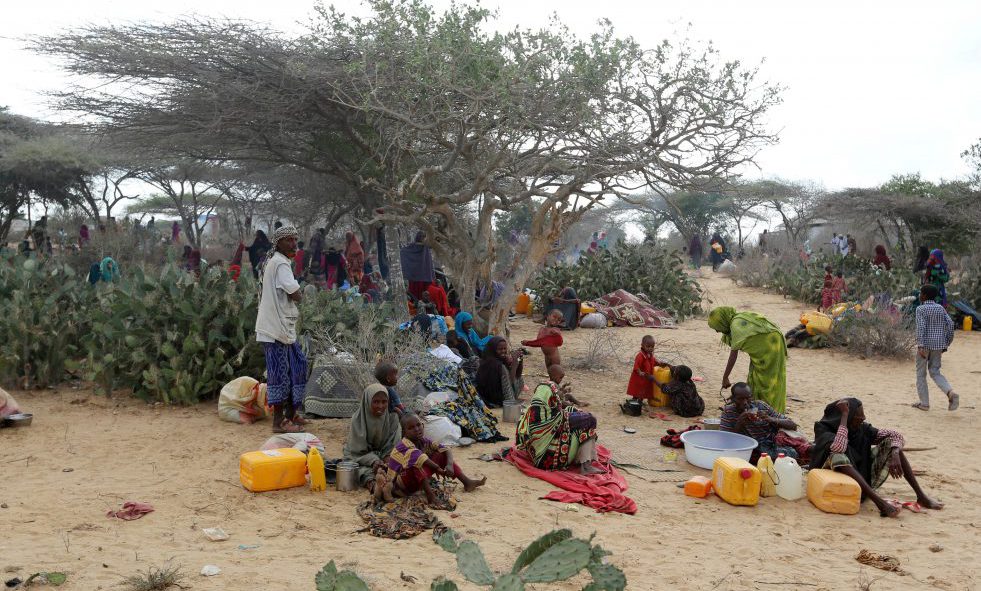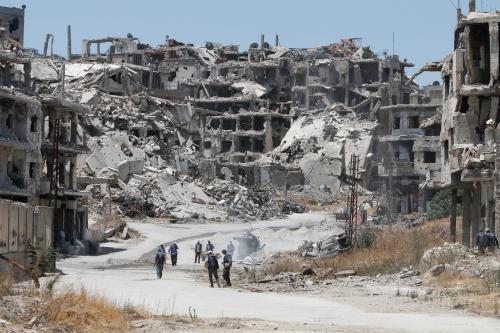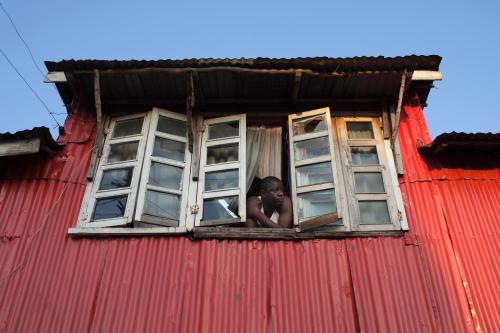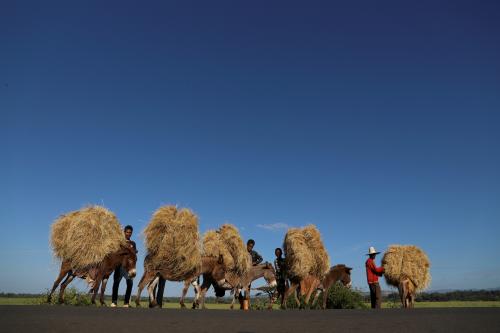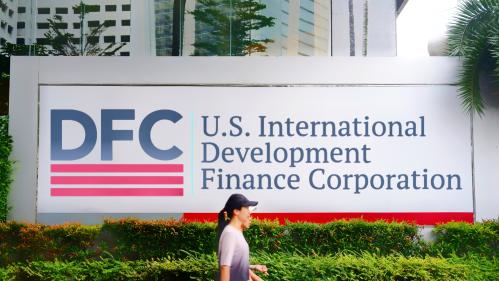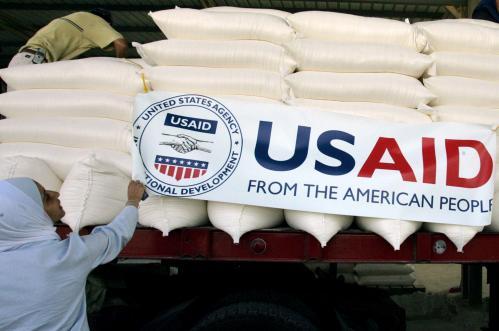From August 2-4, the Global Economy and Development Program at Brookings will host the 14th Annual Brookings Blum Roundtable, “U.S. Foreign Assistance Under Challenge.” The following is one of six briefs on topics to be highlighted at the roundtable.
Despite enormous gains in poverty reduction and a long, steady drop in global violence over the past 70 years, progress is stubbornly stalled in those states considered most fragile. In the last decade, rising levels of violent conflict in states and regions like Syria, South Sudan, Yemen, Libya, Nigeria, and East Africa have spawned four civil wars, the specter of four famines, and historic numbers of people displaced by violence, all of which are straining the global humanitarian system and threatening precious development gains. The world has responded with ever-larger packages of humanitarian, military, and peacekeeping action. What remains missing, however, is a concerted focus on the underlying dynamics of fragility, which will ultimately require a different way of doing business and, importantly, a shared blueprint for action among political, security, development, and humanitarian actors.
Over the past decade, global communities of policymakers, researchers, and practitioners have increasingly understood that the causes of violence and civil war are rooted in fragility, with a growing consensus on key points of action. Now, with the global system straining from multiple crises, the time is right to build on these early steps to eliminate extreme poverty and build a more secure peaceful and inclusive global community.
Fragility defined
At its core, fragility is the absence or breakdown of the social contract between people and their government. Fragile states suffer deficits of institutional capacity and political legitimacy that increase the risk of instability and violent conflict, sapping the state of resilience to disruptive shocks.
The source of this state-society dysfunction—fragility—can be an absence of legitimacy, effectiveness, or both. Legitimacy is weakened when institutions are not inclusive or responsive to all identity groups, including minority and marginalized populations. Repressive, corrupt states undermine citizen confidence in government. Effectiveness is diminished when state-society interactions fail to meet their citizens’ needs and expectations for security, health, economic well- being, and social welfare. High levels of fragility—whether caused by ineffectiveness, illegitimacy, or both—create enabling conditions for armed conflict and political instability.
Why fragility matters
Fragility is the common denominator of many of the steepest global challenges today. Several decades of research have identified the strong correlation of state fragility with higher levels of violent conflict, extreme poverty, violent extremism, and greater vulnerability to the shocks of natural disasters or the predations of regional and international powers. A growing number of indices directly measure state-society dysfunction and make it possible to track and rank key elements of fragility at the national and sub-national levels. The combined insights from these assessments have clarified the stark statistical relationship between fragility and the multiple challenges to global development, peace, and security:
- The top seven states responsible for the largest number of refugees and migrants in 2016 (Syria, Afghanistan, South Sudan, Somalia, Sudan, Democratic Republic of Congo, and Central African Republic) rank at or near the top of nearly every index of fragility.1
- Five of the 10 most fragile states were also among the 10 largest sources of terrorist attacks in 2016.2
- An estimated 1.5 billion people live in fragile or conflict affected countries, and on average, a country that experienced major violence from 1985-2005 has a poverty rate 21 percent higher than a country with no violence, according to the 2011 World Development Report.
- More than half the people seriously affected by natural disaster live in fragile and conflict- affected states, according to the World Bank.
Conflicts are increasingly international and therefore much harder to solve, providing proxy ground for external powers to manipulate fragile institutions, exercise their own interests, and flex their muscles. These conflicts are lasting longer and costing more: various estimates of the costs of global conflict range from $9 trillion to $13.6 trillion per year.3 New and more virulent forms of violent extremism like Boko Haram and Islamic State have exploited historic grievances to recruit followers, both voluntarily and by force, and established hold-over territory. And, historical levels of refugees and migrants—driven out of their homes by violent conflict and poverty in countries like Syria—have overflowed onto the shores of Europe, contributing to the political destabilization of key U.S. allies in Europe.
Fragile states often lack the institutional capacity to respond quickly and effectively to control the spread of pandemic disease outbreaks. With the experience of an outbreak of Ebola in Guinea, Liberia, and Sierra Leone in 2015, and the more recent outbreak of Zika in parts of Latin America, the specter of uncontrolled pandemics has never loomed larger.
The fragility challenge
Fragility is not a new concept, but represents a stubborn challenge to address effectively. Each situation is different, but there are some common reasons for this failure:
- Global action is typically reactive and short term, driven by crisis rather than by prevention.
- Bureaucratic impediments provide disincentives for more effective and coordinated action, with government and United Nations agencies divided into silos, often with overlapping mandates turfs and earmarked funding for sector specific activities. This inhibits the ability to address the core drivers of fragility through comprehensive programs that integrate activities such as governance and peacebuilding programs into traditional development sectors like health, education, economic growth, and natural resource management.
- Core drivers of fragility are often perceived to be too political and therefore outside development action, which instead has a traditional focus on investing in productive economic growth and advancing key sector objectives such as health, agriculture, or education. The U.N. Millennium Development Goals (MDGs) mirrored this approach with eight goals to end global poverty. Although far exceeding expectations, the MDGs conspicuously avoided any of the challenges posed by conflict, inequity, or lack of human rights and justice. At their conclusion in 2015, poverty was increasingly concentrated in the most fragile countries.
- Fragility represents a complex set of issues that requires security, development, and political actors working together—it cannot be solved by development action alone.
A paradigm shift in the development world
In 2011, the World Bank released its landmark World Development Report: Conflict, Security, and Development, calling for a different approach to help fragile states emerge from cycles of conflict by investing in an integrated set of activities emphasizing citizen security, access to justice, and job creation. This report consolidated a growing body of evidence and helped catalyzed useful changes within the relief and development field, including:
1. Fragile states self identify for the first time
In 2011, the International Dialogue on Peacebuilding and State Building announced the New Deal for Engagement in Fragile States. The New Deal called for new ways to invest financially and politically in fragile states, based on an agreement between self-identified fragile state governments (known as the g7+), international donors, and civil society organizations and designed explicitly to create more inclusive, accountable systems of governance.4
The New Deal’s five peacebuilding and statebuilding goals (PSGs) built upon growing collective wisdom on the most effective ways to help fragile countries move toward greater peace: Foster inclusive political settlements and conflict resolution; establish and strengthen people’s security; address injustices and increase people’s access to justice; generate employment and improve livelihoods; and manage revenue and build capacity for accountable and fair service delivery.
Unfortunately, support and engagement of the New Deal has been largely limited to international development agencies and the finance and planning ministries of the g7+ countries. To realize its full transformative potential, support for the New Deal will have to be expanded in both donor governments and fragile states to include security, political, and development departments, and to be more genuinely inclusive of civil society. The potential of the New Deal has fallen short of initial expectations, but it retains promise as a model for the kind of compact that could create greater coherence and effectiveness in providing a carrot-and-stick approach to those states trapped in fragility and conflict.
2. Sustainable Development Goals prioritize inclusivity and accountability
The U.N. Sustainable Development Goals (SDGs) adopted in 2015 recognize that development investments cannot be sustained unless states and societies are inclusive, accountable, and just. After tough negotiations among member states that pushed back against potential sovereignty infringement, SDG 16 was included, which seeks to promote peaceful and inclusive societies for sustainable development, provide access to justice for all, and build effective, accountable, and inclusive institutions at all levels
3. Refugee crises fuels rethink of development and humanitarian architecture
In May 2015, the first ever Global Humanitarian Summit was held in Turkey, where more than 9,000 humanitarian, development, and political participants from 173 countries convened to seek solutions to acute violent conflict and historic displacement. Key agreements focused on breaking down the stovepipes between humanitarian and development activities and adopting a greater emphasis on understanding and addressing the drivers of violent conflict. In one encouraging result, the World Bank is opening new windows of concessionary funding for states like Jordan and Lebanon to address the strain from the massive onslaught of refugees and to forestall them from collapsing into crises as well. The World Bank’s 18th Replenishment of the International Development Association (IDA18) is the largest replenishment in IDA’s 56-year history and has a bold new focus on increasing attention and investment in fragile states, acknowledging the core development challenge they represent.
4. The Resilience Agenda gained ground in response to crippling droughts
The “Resilience Agenda” emerged in the development world in the aftermath of the crippling droughts in the Horn of Africa and the Sahel in 2011–2012. Defined as the ability of households, communities, states, and systems to absorb shocks while continuing to make positive advances, resilience provided an important framework for more effectively reducing the risk of recurring disasters by providing a shared roadmap for action among political, development, and humanitarian actors, international donors, local governments, and communities.
While there is an ongoing academic debate about the conceptual relationship of fragility and resilience, the resilience agenda usefully focuses on the positive attributes necessary to absorb shocks. It successfully catalyzed critical action among international donors, drought affected states, and humanitarian and developments practitioners and offers useful lessons for addressing fragility:
- Early action in response to early warning
- Working across silos to jointly plan, fund, and implement responses
- Country leadership
- Civil society engagement
- Coordination of local governments and international partner responses.
Kenya has significantly progressed with its resilience efforts, which were coupled with a push for government decentralization that put capable, accountable government officials closer to their communities. Kenya increased investment in the formerly marginalized drylands of the northeast and established an effective platform for joint and coordinated action among donors. As a result, millions of people have been protected from falling into greater crisis during the 2017 drought now gripping the region.
Tackling the challenge
An escape from the fragility trap is imperative to addressing global poverty, the currently overstretched global humanitarian system, and critical security challenges. The core principles articulated in the 2011 World Development Report, the New Deal for Fragile States, the SDGs, and lessons from the Resilience Agenda all point to a broad blueprint for action:
- Invest in security and justice for all citizens
- Support legitimate government, characterized by inclusive politics, accountable institutions, and reconciliation
- Cultivate locally owned and led solutions where partnership is possible
- Invest in inclusive, equitable economic growth
- Work across traditional silos to address the systemic challenges of conflict
- Sustain engagement given generational nature of the challenges
- Work in multilateral and regional partnerships
This is not a blueprint for state-building by the international community, but rather a way to make investments more effective in those fragile states where partnership is possible. Importantly, how- ever, this blueprint requires greater alignment between development, security, and political actors for joint action.5 In the absence of this coordination, too often the shorter-term horizons and different analytic frameworks of security and diplomatic considerations can undercut an agenda for longer-term, necessary change.
Colombia offers a useful case study in the effectiveness of a sustained engagement across three U.S. government administrations, working closely with country leadership, and coordinating political, security, and development approaches. A failed narco-state with the highest global levels of internal displacement concluded a peace deal in 2016 that ended 50 years of civil conflict.
Similarly, Myanmar illustrates the potential of a coordinated international partnership using diplomatic carrots-and-sticks—aligned with development investments focused on inclusive economic growth, civil society, and the institutions of an emerging democracy—in support of locally led initiatives. In November 2015, Myanmar held its first openly contested election since 1990, with the new parliament electing the first non-military president since the country’s military coup in 1962.
There will inevitably be tensions and trade-offs between security, diplomatic, and development objectives, but addressing the root causes of fragility will ultimately require closer alignment. This reality is increasingly embraced by the U.S. military, which has experienced the limits to its capabilities over the last decade. The current level of global crisis may serve as the catalyst necessary to make these changes.
The Brookings Institution is a nonprofit organization devoted to independent research and policy solutions. Its mission is to conduct high-quality, independent research and, based on that research, to provide innovative, practical recommendations for policymakers and the public. The conclusions and recommendations of any Brookings publication are solely those of its author(s), and do not reflect the views of the Institution, its management, or its other scholars.
Brookings gratefully acknowledges Richard C. Blum and the Rockefeller Foundation for their generous support of the 2017 Brookings Blum Roundtable.
Brookings recognizes that the value it provides is in its absolute commitment to quality, independence, and impact. Activities supported by its donors reflect this commitment.
-
Footnotes
- See Fragile States Index 2017; Global Peace Index 2017; Global Perceptions Index 2016;Global Terrorism Index 2017
- See Fragile States Index; Global Terrorism Index 2017
- See Global Peace Index 2016; World Bank: The Price of Conflict, The Prospect of Peace 2016
- The New Deal outlined new modes of operation for donor nations, including committing to locally owned and led development priorities, and making planning processes more inclusive in the target countries. This new method of working was designed to promote five foundational “Peacebuilding and Statebuilding Goals” (PSGs):http://www.pbsbdialogue.org/en/.
- Fragility Study Group, “U.S. Leadership and the Challenge of State Fragility,” 2016, (https://www.usip.org/sites/default/files/ US-Leadership-and-the-Challenge-of-State- Fragility.pdf) offers principles for engagement in fragile states and specific recommendations for more effective action across the US government, with international partners and with fragile states.

